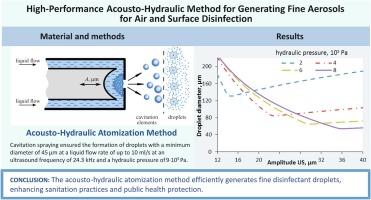High-Performance Acousto-Hydraulic method for generating fine aerosols for air and surface disinfection
IF 9.7
1区 化学
Q1 ACOUSTICS
引用次数: 0
Abstract
Liquid atomization is utilized across various industrial applications, including nanopowder production, spray drying, fuel combustion, coating applications, emulsion preparation, and in medical devices. The use of ultrasonic energy for atomization offers advantages in terms of environmental sustainability compared to other methods. Notably, ultrasonic atomization can achieve finer dispersion with a narrow droplet size distribution at relatively low energy consumption, which is crucial for certain technological applications. One significant application of fine liquid atomization technology is in the disinfection of air and surfaces. The development of efficient and eco-friendly methods for air and surface disinfection has become particularly relevant in light of the spread of dangerous infections, such as the coronavirus. However, ultrasonic liquid atomization is characterized by low flow rate, limiting its applicability. The creation of a combined method that integrates the benefits of both ultrasonic and hydraulic atomization could enhance process efficiency while maintaining high droplet fineness. This study investigates the physical processes involved in cavitation-based aerosol formation and describes the design of an acousto-hydraulic atomizer for implementing the proposed combined atomization method. Theoretical and experimental analyses identified the critical conditions for the transition to the optimal spray mode and key characteristics of atomization. It was found that the simultaneous application of ultrasound and hydraulic pressure enables the production of fine sprays (with a minimum droplet diameters up to 45 µm) at high flow rates (10 ml/s or more). The study demonstrates that the new acousto-hydraulic atomization method can generate a disinfectant aerosol cloud at high speeds. This work highlights the method’s significant potential for sanitary measures, conducted with safety requirements in mind, thereby contributing to the preservation and improvement of public health globally.

用于产生空气和表面消毒用微细气溶胶的高性能声学-水力方法。
液体雾化可用于各种工业应用,包括纳米粉体生产、喷雾干燥、燃料燃烧、涂层应用、乳液制备以及医疗设备。与其他方法相比,使用超声波能量进行雾化具有环境可持续性方面的优势。值得注意的是,超声波雾化能以相对较低的能耗实现更精细的分散和更窄的液滴尺寸分布,这对某些技术应用至关重要。精细液体雾化技术的一个重要应用是空气和表面消毒。鉴于冠状病毒等危险传染病的传播,开发高效、环保的空气和表面消毒方法变得尤为重要。然而,超声波液体雾化的特点是流速低,限制了其适用性。如果能创造出一种综合方法,将超声波雾化和液压雾化的优点融为一体,就能在保持高液滴细度的同时提高工艺效率。本研究调查了基于空化的气溶胶形成所涉及的物理过程,并介绍了用于实施所建议的组合雾化方法的声学-液压雾化器的设计。理论和实验分析确定了过渡到最佳喷雾模式的临界条件和雾化的关键特征。研究发现,同时应用超声波和液压可在高流量(10 毫升/秒或更高)条件下产生精细喷雾(最小雾滴直径可达 45 微米)。研究表明,新的声-液雾化方法可以在高速条件下产生消毒剂气溶胶云。这项工作凸显了该方法在卫生措施方面的巨大潜力,同时考虑到了安全要求,从而有助于保护和改善全球的公共卫生。
本文章由计算机程序翻译,如有差异,请以英文原文为准。
求助全文
约1分钟内获得全文
求助全文
来源期刊

Ultrasonics Sonochemistry
化学-化学综合
CiteScore
15.80
自引率
11.90%
发文量
361
审稿时长
59 days
期刊介绍:
Ultrasonics Sonochemistry stands as a premier international journal dedicated to the publication of high-quality research articles primarily focusing on chemical reactions and reactors induced by ultrasonic waves, known as sonochemistry. Beyond chemical reactions, the journal also welcomes contributions related to cavitation-induced events and processing, including sonoluminescence, and the transformation of materials on chemical, physical, and biological levels.
Since its inception in 1994, Ultrasonics Sonochemistry has consistently maintained a top ranking in the "Acoustics" category, reflecting its esteemed reputation in the field. The journal publishes exceptional papers covering various areas of ultrasonics and sonochemistry. Its contributions are highly regarded by both academia and industry stakeholders, demonstrating its relevance and impact in advancing research and innovation.
 求助内容:
求助内容: 应助结果提醒方式:
应助结果提醒方式:


